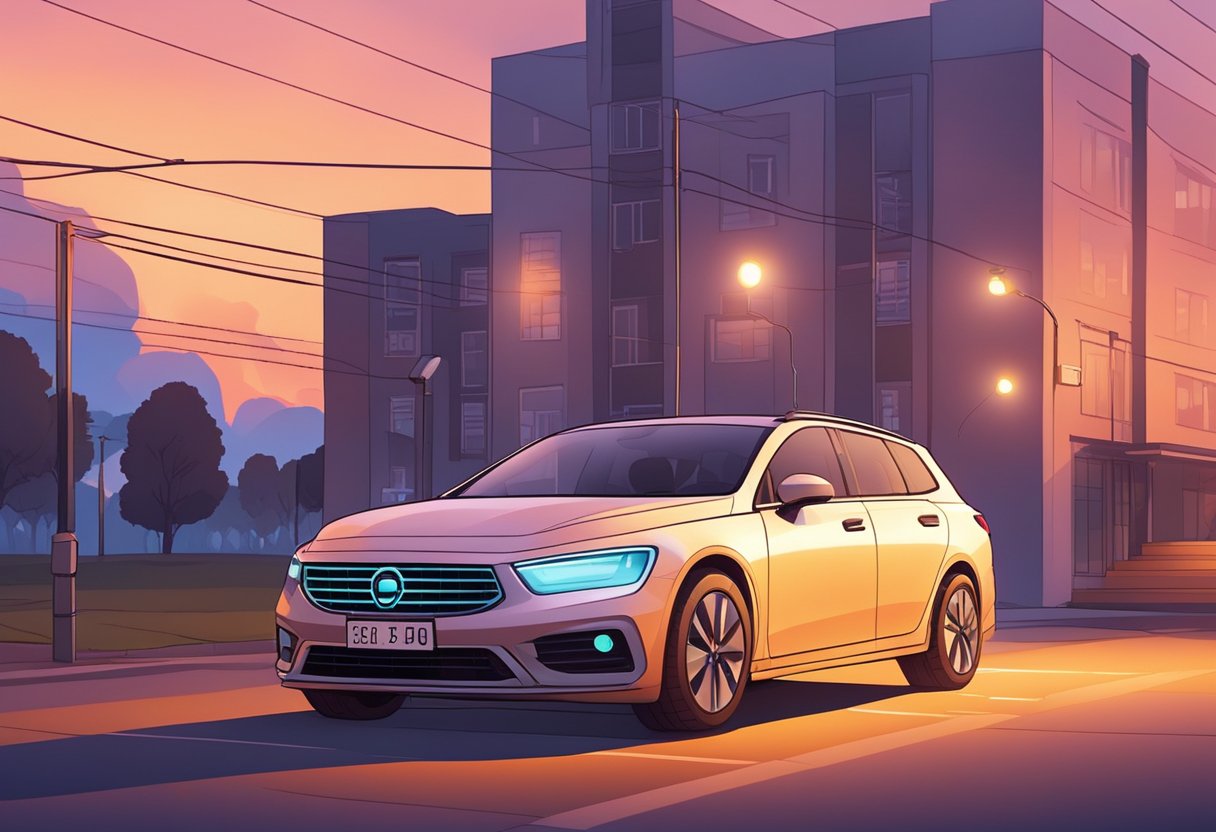Parking lights, also known as sidelights, are a type of automotive lighting that are often overlooked and misunderstood.
These lights are typically located at the front and rear of a vehicle and are used for a variety of purposes.
In this article, we will explore the purpose and usage of parking lights, and provide you with a better understanding of their importance.
One of the primary purposes of parking lights is to increase the visibility of a parked vehicle, especially in low-light conditions.
When parked on the side of the road, turning on your parking lights can help alert other drivers of your presence and prevent accidents.
Additionally, parking lights can also be used to provide additional lighting when loading or unloading your vehicle at night.
Another common usage of parking lights is as a signal to other drivers that your vehicle is in motion, but not necessarily turning.
When driving in low-light conditions, turning on your parking lights in addition to your headlights can help increase your visibility to other drivers.
However, it is important to note that parking lights should not be used as a replacement for headlights, as they do not provide enough illumination to safely navigate the road.
Understanding Parking Lights
Definition and Function
Parking lights, also known as sidelights or marker lights, are a set of small lights located on the front and rear of a vehicle.
They are designed to provide a low level of illumination to make the vehicle more visible when it is parked or when it is stopped on the side of the road.
The purpose of parking lights is to provide a visual warning to other drivers that your vehicle is present, especially in low light conditions.
They are not intended to be used as a substitute for headlights or taillights, but rather as a supplement to them.
In most vehicles, parking lights are activated by turning on the vehicle’s headlight switch and then turning it back one notch.
This will turn on the parking lights while leaving the headlights off.
With the parking lights on, your vehicle will be more visible to other drivers, but it will not be as bright as it would be with the headlights on.
Historical Context
Parking lights have been a standard feature on vehicles for many years.
They were first introduced in the early 1900s as a way to make vehicles more visible when parked on the side of the road.
At that time, vehicles did not have the same level of lighting that they do today, so parking lights were an important safety feature.
Over the years, the design and placement of parking lights have changed, but their function remains the same.
Today, most vehicles have parking lights located on the front and rear of the vehicle, with some vehicles also having additional lights on the sides.
In conclusion, parking lights are an important safety feature on vehicles.
They provide a low level of illumination to make your vehicle more visible when parked or stopped on the side of the road.
By understanding their function and proper usage, you can help keep yourself and other drivers safe on the road.
Legal Aspects of Using Parking Lights
Regulations and Requirements
When it comes to the use of parking lights, there are specific regulations and requirements that you need to follow to avoid getting into trouble with the law.
In most countries, the use of parking lights is only allowed when the vehicle is parked or when it’s being used as a warning signal.
In the United States, for example, the use of parking lights while driving is illegal and can result in a fine.
However, in some states, you can use your parking lights while driving in adverse weather conditions such as heavy rain, snow, or fog.
It’s essential to check the laws in your state or country to ensure that you’re not violating any regulations.
Variations by Country/Region
The regulations regarding the use of parking lights can vary from country to country and even from region to region.
For instance, in some European countries, it’s mandatory to use parking lights when driving in tunnels.
In other countries, such as Japan, it’s common to see vehicles with their parking lights on during the day to increase visibility.
It’s crucial to understand the regulations and requirements regarding the use of parking lights in your area.
This will not only help you avoid getting into trouble with the law but also ensure that you’re using your parking lights correctly and effectively.
In conclusion, the use of parking lights is subject to specific regulations and requirements that vary from country to country.
It’s essential to understand these regulations and requirements to avoid getting into trouble with the law and ensure that you’re using your parking lights correctly.
Practical Applications
When to Use Parking Lights
Parking lights are often used in situations where you need to leave your car parked for a short period of time, such as when you’re running into a store or picking up a passenger.
They can also be used when you’re parked on the side of the road at night, to make your car more visible to other drivers.
It’s important to note that parking lights should not be used while driving.
They are not bright enough to illuminate the road ahead, and using them while driving can be dangerous.
Safety Considerations
While parking lights can be useful in certain situations, it’s important to use them safely.
Here are a few things to keep in mind:
- Always turn off your engine and headlights before using your parking lights. This will help prevent your battery from draining.
- Make sure your parking lights are working properly before using them.
If they’re not, you may need to have them repaired or replaced.
- Don’t rely on your parking lights as your only source of illumination at night.
If you’re parked on the side of the road, turn on your hazard lights or use a flashlight to make yourself more visible to other drivers.
- Remember that parking lights are not a substitute for common sense.
If you’re parked in an unsafe location, it’s better to find a different spot or wait until it’s safer to park.
By using your parking lights responsibly, you can help make yourself and your car more visible to other drivers, and avoid any unnecessary accidents or problems.
How Parking Lights Work
Parking lights, also known as sidelights or marker lights, are a type of automotive lighting that is designed to be used when the vehicle is parked or stationary.
They are typically located on the front and rear of the vehicle and are used to increase visibility and provide a warning to other drivers.
Components and Design
Parking lights are usually designed to be small and low-powered, with a clear or amber lens that diffuses the light.
They are typically mounted on the side of the vehicle and are angled slightly downward to provide a low-level illumination of the road surface.
The most common type of parking light is the incandescent bulb, which uses a filament that is heated by an electric current to produce light.
However, LED (Light Emitting Diode) parking lights are becoming increasingly popular due to their energy efficiency and longer lifespan.
Electrical Systems
Parking lights are typically wired into the vehicle’s electrical system and are controlled by a switch on the dashboard or steering column.
When the switch is turned on, the parking lights are activated, and a small amount of power is sent to the bulbs.
In some vehicles, the parking lights may be wired to turn on automatically when the ignition is turned off, providing additional visibility for the vehicle when it is parked.
However, this feature may be disabled in some areas due to local regulations.
Overall, parking lights serve an important purpose in ensuring the safety of both the driver and other road users.
By providing a low-level illumination of the vehicle when it is parked, they increase visibility and reduce the risk of accidents or collisions.
Maintenance and Troubleshooting
Regular Maintenance
To ensure the proper functioning of your parking lights, it is important to perform regular maintenance.
This includes checking the bulbs, cleaning the lenses, and inspecting the wiring.
First, check the bulbs regularly to make sure they are not burnt out or damaged.
If a bulb is not working, replace it immediately to avoid any safety hazards.
Second, clean the lenses of your parking lights regularly to ensure maximum visibility.
Use a soft cloth and a mild soap solution to clean the lenses.
Avoid using abrasive materials or harsh chemicals that could damage the lenses.
Third, inspect the wiring of your parking lights periodically to ensure that there are no loose connections or damaged wires.
If you notice any issues, have them repaired by a professional mechanic.
Common Issues and Solutions
Despite regular maintenance, parking lights can still experience issues. Here are some common problems and solutions:
-
Parking lights won’t turn on: If your parking lights won’t turn on, check the bulbs first.
If the bulbs are fine, check the fuses and wiring. If you are unable to diagnose the issue, seek the help of a professional mechanic.
-
Parking lights flicker or dim: If your parking lights flicker or dim, it could be due to a loose connection or a faulty alternator.
Have a mechanic inspect your vehicle to diagnose and repair the issue.
-
Parking lights stay on: If your parking lights stay on even when the vehicle is turned off, it could be due to a faulty switch or relay.
Have a mechanic inspect your vehicle to diagnose and repair the issue.
By performing regular maintenance and addressing any issues promptly, you can ensure that your parking lights function properly and provide maximum visibility while driving.
As an Amazon Associate we earn from qualifying purchases.













